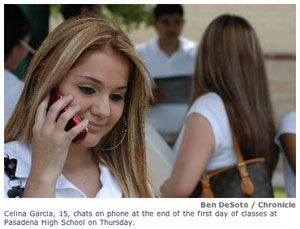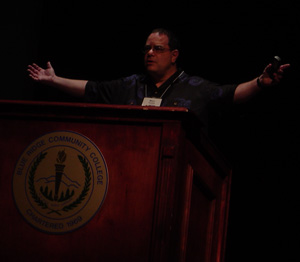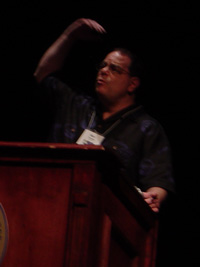 Yesterday, I was scanning through the Technology & Learning News for August 23, and ran across a story called Gadgets, Gadgets Everywhere.
Yesterday, I was scanning through the Technology & Learning News for August 23, and ran across a story called Gadgets, Gadgets Everywhere.
Technology’s steady advance has made the challenge of controlling students’ use of electronic gadgets – cell phones, handheld video games, MP3 players – during school time ever more difficult.
It’s a lead into a story published in the August 14 issues of the Houston Chronicle, called Schools Try to draw the line for wired kids.
VETERAN teacher Andy Dewey has taken to quizzing his students on a new subject  where their hands are.
Tucked away in pockets or camouflaged behind backpacks, hidden fingers could be typing text messages, surfing the Web or even taking pictures. In today’s era of tiny, high-tech devices, it’s a constant struggle to make sure hands are kept in plain sight, he said.
OK, our kids are connected. Technology is part of their lives. But lets try to picture this in a different way. As you are, by now, accustomed to my saying, “It’s not technology, it’s information”. These gadgets are their links to information. They talk, text message, and google with their mobile phones, IM on their laptops, access the world wide web, Net-based video games like Halo, MMORPG (did I get that right?) games like EverQuest and Second Life. These gadgets represent intellectual appendages to our children. They are the hands and feet that carry children to new experiences, and cutting these links is like cutting an appendage — and that makes no constructive sense to these children and their world view.
Yet we try to cut it off. And it’s because of something that David Weinberger said in his keynote address at NECC, something that I have carried with me ever sense.
Weinberger talked about the traditional view of knowledge as being something that could be put in a container. He described Encyclopedia Britannica as 33 volumes with 65,000 articles, that it will never hold more than 65,000 articles, because they will never add a 34th volume. By the way, the shipping weight of Encyclopedia Britannica is 125 pounds.
The Wikipedia, on the other hand, holds nearly 600,000 articles (that was late June 2005). At this moment, it is approaching 700,000 [694,000] articles. At .002 pounds an article, Wikipedia would way three-quarters of a ton right now. Add in the other languages and we’re approaching two tons — and no matter how big it gets, it will never get any harder to find your information. He went on to talk about dewey decimal and how the shelves of a decimal based container system can hold only so much information, forcing us to make decisions on what’s going to be put there.
- 88 numbers for Christianity and its related topics
- 1 for Judism
- Islam and all of its related groups get 1
- Budhists go to the right of the decimal
But this idea of containers was what our lives were about. Even the schedule of the day. During the summer months, we played in the neighborhood. But darkness was a border to the daylight container, and we went home. You could play in the daylight, but not in the dark. However, my children, during their summer months, are up until 4:00 in the morning, with friends, playing video games, and IMing. Darkness means nothing to them because it does not limit their intellectual appendages.
Starting tonight, we are forcing my Son back into a container schedule, because tomorrow he goes back to his learning container (his school), where he’ll receive information containers (textbooks), tied to our knowledge container (the standards), and we will struggle to control their gadgets, cutting off their intellectual appendages, because…
Our schools are leaking!
Through their mobile phones, wireless handhelds, mobile game systems, their laptops, and a simple, yet pervasive sense of a broader world that ignores time and distance, our children’s attention is leaking out of our classrooms, our textbooks, and our state and national standards.
The question that looms overhead is…
Do we continue to container our children, amputating their intellectual appendages during “learning” time?
or
Do we try to integrate learning into the flow of their attentions, taking advantage of the new porous nature their lives, using their appendages to connect children to the world that we are teaching them about?
If we decide to join the flow, what does that look like?
- Do textbooks go away? No, textbooks can lay open beside of a laptop, or textmessaging mobile phone (though I suspect that textbooks will be evolving into something else).
- Do we abandon our classroom and go exclusively online? No, though I suspect that we may be able to teach our children better by spending less time in the classroom and more time working and playing the information outside the classroom.
- Do we still need teachers with a teacher’s desk, chalk board, and pointer? Yes, though the chalkboard must change as must the pointer. However, our definition of what a teacher does will change from that of delivering skills and content, to that of creating and crafting experiences through which students will learn to teach themselves.
- Will the class bell go away? No, but study hall and homework are going to become something entirely different.
- Will college training for teachers change? Yes, but more important than that, the job of being a teacher will also be that of being a student. We will learn constantly, and each day, we will share with our students something that we have just learned.
Your comments are welcomed?
…and, hey, is anyone reading this stuff?

 Yesterday, I was scanning through the
Yesterday, I was scanning through the  I guess that it’s a sign that I am still more teacher than business man, that I would laud, so enthusiastically, my competition. There are probably four or five ed tech conference keynote speakers who are on the A-list of people we all need to hear and see. It’s my aspiration to reach this list, but I found a new model to aspire to yesterday, a new A-lister, by watching Marc Prensky present at the New Directions conference in Flat Rock, North Carolina.
I guess that it’s a sign that I am still more teacher than business man, that I would laud, so enthusiastically, my competition. There are probably four or five ed tech conference keynote speakers who are on the A-list of people we all need to hear and see. It’s my aspiration to reach this list, but I found a new model to aspire to yesterday, a new A-lister, by watching Marc Prensky present at the New Directions conference in Flat Rock, North Carolina. I just got a call, and had to miss the first few minutes of Marc Prensky. He’s talking about digital natives and digital immigrants, and excellent way to explain the differences between us and our students.
I just got a call, and had to miss the first few minutes of Marc Prensky. He’s talking about digital natives and digital immigrants, and excellent way to explain the differences between us and our students.